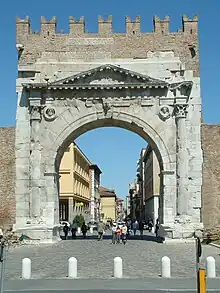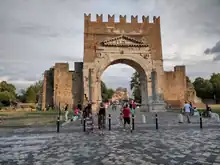44°03′25.01″N 12°34′15.47″E / 44.0569472°N 12.5709639°E

The Arch of Augustus is a gate in the former city wall of Rimini, Italy, in the form of a Roman honorary or triumphal arch.[1] The arch was dedicated to the Emperor Augustus by the Roman Senate in 27 BC and is claimed to be the oldest large Roman arch still surviving. It marked the end of the via Flaminia, which connected the cities of Romagna to Rome, and spans the modern Corso d'Augusto (the ancient decumanus maximus), which led to the beginning of another road, the via Emilia, which ran northwest to Piacenza.[2]
Appearance
.jpg.webp)
Its style is simple, but solemn. The arch is of exceptional size, 8.84 metres across, with a depth of 4.10 metres and a height of 10.40 metres.[3] The opening is flanked by two engaged columns with fluted shafts and Corinthian capitals.[4] There is a rather low triangular pediment, but this does not extend to cover the tops of the columns, but is "poised uneasily between them",[5] creating an inelegant effect,[6] and showing that at least in provincial Italy, the principles of Greek-derived classical architecture were not yet fully grasped. The similar Arco dei Gavi, Verona, of perhaps twenty years later, shows a better understanding of them.

The two sides of the arch were identical, but the outer face is now better preserved, with the columns reaching up to their capitals, which they do not do on the inside face. The four clipei (shields) placed next to the capitals each depict Roman divinities: Jupiter and Apollo on the Roman side, Neptune and Roma facing the city of Rimini. The keystone of the arch on each side has a projecting bull;[7] that on the inside face is better preserved.

According to Dio Cassius and a fairly plausible local legend, the gate was surmounted by a lavish bronze statue of Augustus, probably gilded, and perhaps driving a quadriga.[8]
The main peculiarity of this arch is that the archway is especially large for a gate of the time;[9] it probably could not be closed by doors. The explanation is perhaps that the peaceful policy of Augustus, the so-called Pax Romana, made a civic gate that could be closed seem unnecessary, since there was no danger of attack.
The brick battlements (merlons) on the upper part date to the medieval period (10th century),[10] at which time the city came to be held by the Ghibellines.[11]
History
The gate remained in use after antiquity with some modifications. In the Bavarian Code, a codex containing the church of Ravenna's investitures between the 8th and 10th centuries, it is called the Gate of Saint Gaudentius,[12] after Gaudentius of Rimini, who was buried in a necropolis outside the city's walls.[12][13]
The arch remained one of the city gates until the Fascist period, when the city wall was demolished and the arch was left as an isolated monument.
The arch was well known in the Renaissance, and probably influenced the never-completed facade of the nearby Tempio Malatestiano by Leon Battista Alberti, designed in 1450.[14]
Along with the Bridge of Tiberius, it is today one of the symbols of Rimini, so important that it appears on the city's coat of arms.[15]
Inscription

The Latin inscription above the arch on the outer face is restored to read:
SENATVS POPVLVSQVE ROMANVS
IMPERATORI CAESARI DIVI IVLI FILIO AVGVSTO IMPERATORI SEPTEM
CONSOLI SEPTEM DESIGNATO OCTAVOM VIA FLAMINIA ET RELIQVEISCELEBERRIMEIS ITALIAE VIEIS ET AVCTORITATE EIVS MVNITEIS
The Senate and People of Rome [dedicated this arch]
to Imperator Caesar Augustus, son of the divine Julius, Imperator seven times,
Consul seven times and consul-elect for an eighth time, on account of the via Flaminiaand the other very distinguished roads of Italy having been repaired by his auctoritas.
See also
- Arch of Augustus (disambiguation) for other such arches
- List of Roman triumphal arches
Notes
- ↑ Favro
- ↑ "Arco d'Augusto"
- ↑ "Arco d'Augusto"
- ↑ "Arco d'Augusto"
- ↑ Boëthius, Axel; Ward-Perkins, John Bryan (1970). Etruscan and Roman Architecture. Pelican History of Art (2nd ed.). Penguin. p. 308.
- ↑ Favro
- ↑ "Arco d'Augusto"; Favro
- ↑ Favro; "Arco d'Augusto"
- ↑ Favro
- ↑ "Arco d'Augusto"
- ↑ Favro
- 1 2 "La Gambalunga racconta: San Gaudenzio patrono di Rimini" [Gambalunga tells: Saint Gaudentius, patron saint of Rimini]. Biblioteca Civica Gambalunga (in Italian). Retrieved 11 January 2024.
- ↑ "27 maggio 359 - L'imperatore Costanzo II convoca il Concilio di Rimini" [27 May 359 – Emperor Constantius II convenes the Council of Rimini]. Chiamami Città (in Italian). 26 May 2023. Retrieved 11 January 2024.
- ↑ Favro
- ↑ Rimini's coat of arms
References
- "Arco d'Augusto", Rimini official tourism site
- Favro, Diane, entry in the Encyclopedia of the History of Classical Archaeology, p. 65, 2015, ed. Nancy Thomson de Grummond, Taylor & Francis, ISBN 9781134268542, google books